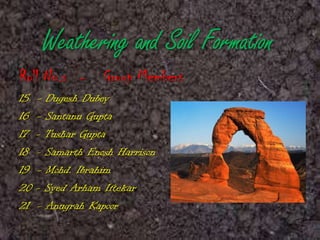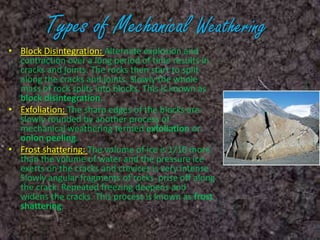Weathering and Soil Formation Class 7
- 1. Weathering and Soil Formation A natural arch produced by erosion of differentially weathered rock in Jebel Kharaz (Jordan). Class -7B Group C
- 2. Weathering and Soil Formation Roll No.s 15 16 17 18 19 20 21 Group Members - Dugesh Dubey - Santanu Gupta - Tushar Gupta - Samarth Enosh Harrison - Mohd. Ibrahim - Syed Arham Iftekar - Anugrah Kapoor
- 3. Weathering Weathering is the fracturing or disintegration and decomposition of rocks by natural agents. It is a static process. There is no movement of weathered material except where the pieces fall due to the force of gravity. Weathering is classified into three types:1. Physical or Mechanical Weathering 2. Chemical Weathering 3. Biological Weathering
- 4. Mechanical Weathering Mechanical weathering is the physical disintegration of rocks due to factors like heat, water and frost. Small pieces or particles of rock prise off from the rock surface. There is no change in the minerals constituting the rock. The end result is soil. Mechanical weathering is more intense when the rock layers are exposed on the surface. ContinuedŌĆ”.
- 5. Types of Mechanical Weathering ŌĆó Block Disintegration: Alternate explosion and contraction over a long period of time results in cracks and joints. The rocks then start to split along the cracks and joints. Slowly the whole mass of rock splits into blocks. This is known as block disintegration. ŌĆó Exfoliation: The sharp edges of the blocks are slowly rounded by another process of mechanical weathering termed exfoliation or onion peeling. ŌĆó Frost shattering: The volume of ice is 1/10 more than the volume of water and the pressure ice exerts on the cracks and crevices is very intense. Slowly angular fragments of rocks prise off along the crack. Repeated freezing deepens and widens the cracks. This process is known as frost shattering.
- 6. Chemical Weathering Chemical weathering is the rotting or decomposition of rocks, under the influence of atmosphere and water. This type of weathering is most common in equatorial and tropical regions where there is enough moisture and heat to start off chemical reactions within rock masses. Acid in groundwater has weathered limestone to form RustyŌĆÖs Cave in Dade County, Georgia.
- 7. Types of Chemical Weathering There are four types of chemical weathering:1. 2. 3. 4. Oxidation: Oxygen present in the air or water reacts with certain minerals present in the rock. Oxides form and the rocks slowly crumble ,for example, iron present I rocks combines with oxygen to form iron oxide or rust. Carbonation: Carbon dioxide present in the atmosphere dissolves with rain water to form a weak acid called carbonic acid. This makes rain water acidic. The acidic rain water reacts with rocks like limestone. Calcium and bicarbonate ions form which are carried away by the water. Hydration: This occurs when hydrogen present in water combines with minerals present in rocks and decomposes it for example, feldspar, a mineral, is converted to kaolin as a result of hydration. Solution: Rain water is able to dissolve certain minerals and chemically weather rocks. Rock salt and gypsum are removed by solution.
- 8. Biological Weathering Biological weathering is a form of weathering caused by growth of roots and burrowing of animals. Plants roots are the most efficient agents of the biological weathering as they give off acids that contributes to break down of rocks. Biological weathering increases with soil thickness until the optima for biotic activity is reached. Trees put down roots through joints or cracks in the rock in order to find moisture. As the tree grows, the roots gradually prize the rock apart.
- 9. Mass Movement Mass movement is the movement of weathered material down on a slope due to gravitational forces. The weathered material is not transported by any agent of erosion. The movement can be sudden or vey gradual depending on the steepness of the slope, amount of weathered material and presence of rain water in the soil.
- 10. Soil Formation Soil is the thin surface layer on the earth, comprising mineral particles formed by the breakdown of rocks, decayed organic matter, living organisms, soil water and soil atmosphere. Soil formation starts with weathering of rock masses and accumulation of weathered particles on the surface of the rock masses. The components of soil are found in all three states of matter.
- 11. Soil Profile A vertical section of the soil from surface down to the bedrock, showing the different horizons is called the soil profile. The horizons or layers have different colours. Generally a soil profile has four horizons:1. Top soil: It contains organic matter and humus. 2. Subsoil: It contains weathered rock material, sand, silt and clay. This layer contains salts and minerals and less humus. 3. Substratum: It consists of large fragments of weathered parent rock material. 4. Bedrock: It provides a base to the three layers above. The layer is unweathered.
- 12. Soil Erosion Soil forms over thousands of years but can be washed away quickly due to the carelessness of mankind. The removal of the fertile top soil by agents of erosion like rain water, rivers, wind and waves is termed as soil erosion. Sheet erosion and gully erosion are the two most common types of erosion. Wave cut platform caused by erosion of cliffs by the sea, at Southerndown in South Wales.
- 13. Soil Conservation 1. 2. 3. 4. Soil erosion has made soils infertile. Unscientific methods of cultivation has led to low yields of crops and washing away of the precious top soil. Soil conservation means to take measures to protect the top soil from being eroded. There are several methods to conserve soil:Contour ploughing Terrace farming and bunding Shelter belts Plugging of Gullies













